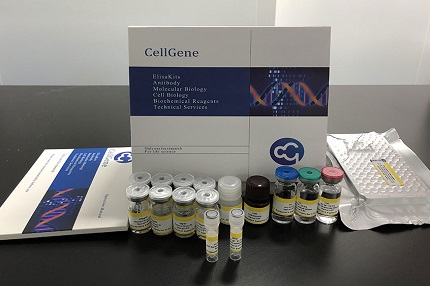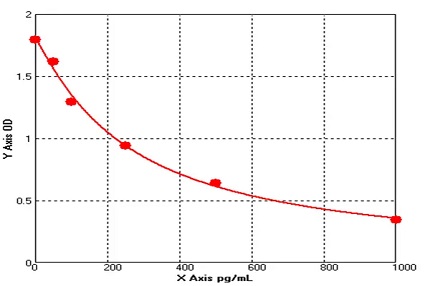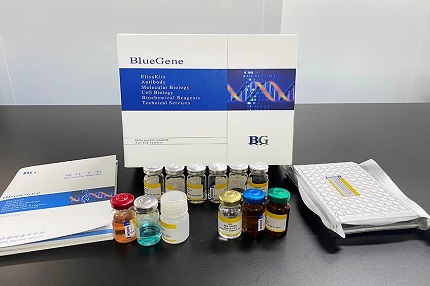E02C0549 Rat Caspase 3 ELISA kit
The Rat Caspase 3 ELISA kit can be used to identify samples from the rat species. Caspase 3 can also be called CPP32, CPP32B, SCA-1, caspase 3, CASP3.


E02C0549 Rat Caspase 3 ELISA kit
The Rat Caspase 3 ELISA kit can be used to identify samples from the rat species. Caspase 3 can also be called CPP32, CPP32B, SCA-1, caspase 3, CASP3.
Product Information | |
Cat. No. | E02C0549 |
Product Name | Rat Caspase 3 ELISA kit |
Species | Rat |
Product Size | 48 Tests / 96 Tests |
Concentration | 1.0-25 ng/ml |
Sensitivity | 0.1 ng/ml |
Principal | Sandwich ELISA |
Sample Volume | 50 ul |
Sample Type | Serum, plasma, cell culture supernatants, body fluid and tissue homogenate |
Assay Time | 90 minutes |
Platform | Microplate Reader |
Conjugate | HRP |
Detection Method | Colorimetric |
Storage | 2-8°C |
Kit Components | ||
MATERIALS | SPECIFICATION | QUANTITY |
MICROTITER PLATE | 96 wells | stripwell |
ENZYME CONJUGATE | 10 mL | 1 vial |
STANDARD A (0.5mL) | 0 ng/ml | 1 vial |
STANDARD B (0.5mL) | 1.0 ng/ml | 1 vial |
STANDARD C (0.5mL) | 2.5 ng/ml | 1 vial |
STANDARD D (0.5mL) | 5.0 ng/ml | 1 vial |
STANDARD E (0.5mL) | 10 ng/ml | 1 vial |
STANDARD F (0.5mL) | 25 ng/ml | 1 vial |
SUBSTRATE A | 6 mL | 1 vial |
SUBSTRATE B | 6 mL | 1 vial |
STOP SOLUTION | 6 mL | 1 vial |
WASH SOLUTION (100 x) | 10 mL | 1 vial |
BALANCE SOLUTION | 3 mL | 1 vial |
Principle of the Assay |
CASP3 ELISA kit applies the quantitative sandwich enzyme immunoassay technique. The microtiter plate has been pre-coated with a monoclonal antibody specific for CASP3. Standards or samples are then added to the microtiter plate wells and CASP3 if present, will bind to the antibody pre-coated wells. In order to quantitatively determine the amount of CASP3 present in the sample, a standardized preparation of horseradish peroxidase (HRP)-conjugated polyclonal antibody, specific for CASP3 are added to each well to “sandwich” the CASP3 immobilized on the plate. The microtiter plate undergoes incubation, and then the wells are thoroughly washed to remove all unbound components. Next, substrate solutions are added to each well. The enzyme (HRP) and substrate are allowed to react over a short incubation period. Only those wells that contain CASP3 and enzyme-conjugated antibody will exhibit a change in color. The enzyme-substrate reaction is terminated by addition of a sulphuric acid solution and the color change is measured spectrophotometrically at a wavelength of 450 nm. A standard curve is plotted relating the intensity of the color (O.D.) to the concentration of standards. The CASP3 concentration in each sample is interpolated from this standard curve. |
Coefficient of Variance | Intra Variation% <10% | |
Inter Variation% <12% | ||
Recovery | 95-102% | |
Linearity | Diluent Ratio | Range % |
1:2 | 93-105 | |
1:4 | 88-106 | |
1:8 | 86-108 | |
Specificity/Cross-reactivity | No significant cross-reactivity or interference between CASP3 and analogues was observed. | |




E02C0549 has been referenced in the below publications:
The Study on Selection of Excellent Bacillus subtilis and Determining its' Growth Performance and Some Biological Indexes.
化痰方对非酒精性脂肪性肝炎细胞因子和Caspase-3含量的影响※。
Effect of Buyang Huanwu Decoction on Neuron Apoptosis and Gene Expression of Caspase-3 in Brains of Rats after Cerebral Ischemia Reperfusion Injury.
The interference of picrosideⅡ on the expressions of Caspase3 and PARP following cerebral ischemia reperfusion injuryin rats.
Comparative study of cardio-protective effects of zinc oxide nanoparticles and zinc sulfate in streptozotocin-induced diabetic rats.
Related Bluegene Biotech Products



